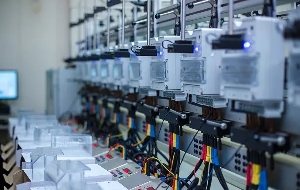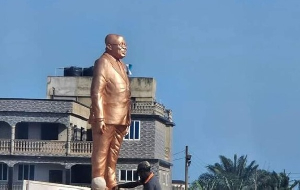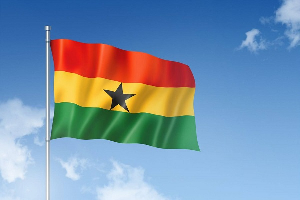On Monday, September 28, 2020, Chairperson of the Electoral Commission Jean Mensa spoke about the just-ended exhibition of the provisional voters register.
She, among other things, explained why some names were omitted from the register.
The missing names prompted the opposition National Democratic Congress (NDC) to raise a fierce protest against the EC.
The EC boss said a process to export the information of registered voters onto secure storage is to blame for the missing names in the register.
“Registration of voters is done using Biometric Registration Devices at the Polling Stations. Thereafter the data is then transmitted to the data centre where it undergoes the process of de-duplication by the Automatic Biometric Identification System (ABIS)," she said.
Read her full remarks below.
REMARKS BY MRS. JEAN MENSA, THE CHAIRPERSON OF THE ELECTORAL COMMISSION OF GHANA REGARDING THE 2020 EXHIBITION OF THE PROVISIONAL VOTERS REGISTER
Good afternoon citizens of Ghana and our friends from the media. We thank the good Lord for this day and for His mercies that are new every morning. He is faithful
Welcome to yet another election of Let the Citizen Know. This session of the Let the Citizen Know is to specifically update the citizenry on the just ended Exhibition of the Provisional Voters Register.
On behalf of the Commission, I thank you sincerely all for the support you have accorded us as we continue with preparations for the Presidential and Parliamentary elections on the 7th December 2020.
I take this opportunity assure all our Stakeholders that the Electoral Commission as currently constituted is resolute in its quest to deliver a credible, fair, transparent and peaceful electoral process and elections for Ghanaians.
As has been our hallmark, the Commission will not relent in providing regular and comprehensive updates to the public at every stage of the electoral process.
Overview of the Exhibition
Ten days ago, on 18th September, 2020, we officially kicked off the 2020 Exhibition of the Provisional Voters Register. I am happy to inform you that the 33,367 Centres across the country that were earmarked for the exercise were all operational and we thank Voters who visited these Centres to verify their details.
As part of the Commission’s commitment to ensure the safety and security of its stakeholders, the Commission put in place stringent safety protocols at all Exhibition Centres throughout country. In addition, the Commission appointed COVID-19 ambassadors to ensure that the safety protocols were adhered to.
The Commission notes that during the first few days of the Exhibition Exercise, participation was lower than anticipated, especially within Centres located in the urban areas. Comparatively, Centres located in rural areas recorded more active participation right from the first day of the Exhibition.
This could partly be attributed to Voters within the urban areas preferring to utilize the Commission’s SMS short code, 1422, to verify their details.
Indeed, due to its convenience, a considerable number of Voters tried to verify their details through the SMS short code ahead of its activation on the first day of the Exhibition Exercise.
This resulted in a long queue within the SMS system after it was activated. Unfortunately a few prospective users who were caught up in the queue did not receive their details and had to re-access the system to obtain their details.
The Commission regrets this. I am happy to note however, that the SMS short code worked efficiently and served its intended purpose of providing a convenient and seamless platform for Voters to verify their details throughout the Exhibition period.
With a view to piloting the Biometric Verification Devices (BVDs) that will be used to verify a voters biometric details on the 7th of December, 2020, the Commission rolled out 5,340 devices during the Exhibition 20 BVDs were deployed to every District.
These devices were successfully used and enabled prospective voters verify their biometric details, i.e. fingerprints and facials features. We are informed by our Officers that those who used the BVDs had a good experience as the technology worked efficiently.
The Commission extended the Exhibition Period to allow further inspection of the Provisional Voters Register. As I indicated, the Commission constantly forwarded updated Registers to the Exhibition Centers. The extension afforded stakeholders the opportunity to verify their details in the updated registers that were sent to Centers.
Purpose of Exhibition
Distinguished Ladies and Gentlemen, Regulations 22(1) and 23(1) of C.I. 91 enjoin the Electoral Commission to compile a provisional register of voters for each polling station indicating the particulars and photograph of each person whose application was received and accepted during the registration and display it for public inspection.
This process is not new and has always formed part of our electoral processes.
The term public inspection refers to the act of citizens carefully examining or scrutinizing the Provisional Voters Register to ensure that its contents are accurate.
The vision of the Law ,akers was to provide stakeholders with an opportunity to unearth problems with the Register for the purpose of fixing and resolving them.
Additionally, the Law goes on to provide for “inclusion” during the Exhibition Exercise to allow persons who registered but whose names are not on the register, to file to be included in the register.
In other words, the Law envisaged that the even the most meticulous process of voter registration is not infallible. It is not full proof and therefore, it provided a clearly spelt out mechanism to correct all errors and omissions detected. This mechanism is the Exhibition Exercise that the Commission has just concluded.
It is important to note, that the Commission comprises competent and diligent men and women who fully understand and respect the great mandate handed to them by our constitution.
However, in the execution of various duties, human and administrative errors do occur, We wish to state unequivocally that we have the ability and the competence to fix and resolve all the outstanding issues with register and we are doing so in an open and transparent manner.
Indeed, to date, a significant number of issues identified at the start have been resolved. We continue to work to reduce the deficit to the barest minimum. We are confident that at the end of the process we will be bequeath Ghanaians with a Register that reflects truth and light. A register that is credible. A register that has integrity.
This was the spirit, and letter of the just ended Exhibition exercise.
Exhibition Statistics
In my last address, I emphasized that the Commission fully upholds the view that central to free, fair and transparent and peaceful elections is credible and accurate data. To achieve this objective it is vital that every eligible citizen is provided the opportunity to not only register as a voter, but verify his/her details.
Over the last ten days, citizens were afforded the opportunity to verify their details to ensure that they are first of all captured in the register and secondly, that their details such as sex, age, name etc. are accurate.
The exhibition was largely successful as it afforded Ghanaian the opportunity to verify their details. Additionally it enabled the Commission to address the gaps in data and fix and resolve issues along the way. It is important to emphasize that the omission of names in some polling stations was widespread. It was not concentrated in particular Regions and Districts as has been alleged.
I am happy to state that six hundred and ninety eight thousand four hundred and four (698,404) Voters verified their details using the Commission’s SMS short code. Similarly, seven million two hundred and seventy one thousand four hundred and ninety eight (7,271,498) Voters verified their details physically at the Exhibition Centres. Combined, this translates to 7,969,887 number of Voters who verified their details during the 2020 Exhibition which constitutes 46.9% of the total number of voters in the Provisional Voters Register. In 2016 the percentage of persons who verified constituted 45% of the total register whist the 2016 registration was conducted over a period of 21 days, the 2020 registration was conducted over a period of 10 days.
Resolution of errors
As I stated earlier we worked throughout the Exhibition Process to resolve significant number of issues on the Provisional Register.
To date, the total number of persons reflected on the Provisional Voters Register stands at Seventeen million and Seven Thousand, seven hundred and twenty-sixty (17,007,26).
We witnessed an increase in the register by 44,420 persons
We still have a deficit of Seven Thousand, Five Hundred and Fifteen (7,515). This constitutes 0.0004% of the total Provisional Voters Register. We will not relent but we will continue to work to ensure that everyone who registered is counted as part of the register. As a Commission we will spare no effort in ensuring that every vote counts.
It is important to inform citizens about the reason for the initial shortfall. Registration of voters is done using Biometric Registration Devices at the Polling Stations. Thereafter the data is then transmitted to the data centre where it undergoes the process of de-duplication by the Automatic Biometric Identification System (ABIS).
In other words, the data is exported for secure storage and for further analysis. The provisional register is then produced that. In a few instances, the process of exportation of data from the USB sticks to the central server was faulty leading to shortfalls of data in some areas
It is important to highlight that although the registration process is IT driven, there is still a significant amount of human involvement that may result in errors in every step of the process from registration to exhibition. In short, due to unintentional human and administrative errors, the process of exportation of data from the BVD kits to the USB sticks and then to the Central Database was a few in instances faulty leading to shortfalls in some areas. In a nutshell our technology performed optimally as expected, however, in some areas, the human element of ours fell short leading to some of the gaps in the data we experienced.
I am happy to note that through a process termed end of life, the Commission has transferred all the data that was on each Biometric Verification Kit used for the registration onto flash drives. This has been updated onto our central server.
In summary we have successfully retrieved and continue to retrieve valid applicants who were missing from the register.
For example, in the case of Ashaiman in the Greater Accra Region, the purported seven thousand plus (7000+) applicants who were said to have been deliberately removed from the Register are on the electronic register with the exception of some One Hundred and Sixty-Five applicants who have to come onto the register through the process of inclusion. This is the same situation for areas such as Korley Klotey, Saula-Tuna- Kalba and Lawra.

It is important to emphasize that as a Commission we have always indicated that the figures we released during the registration are provisional. As such the final count may be above or below the provisional figures earlier provided. We are however working to ensure that no one who registered is denied the right to vote.
DUPLICATE OR SAME IDs NUMBERS
For the information of the general public, during the Registration Process we noted that some applicants had the same ID numbers with others. The Commission’s Registration Kits are completely offline and therefore they issue out Voter ID Cards completely independent of each other. To prevent the duplicating Voter ID numbers, each kit is given a unique set of IDs that it can issue. The issue of Voters having the same ID numbers occurs when during registration a Biometric Verification Kit develops a fault. Its code is then transferred to a new kit to enable the registration to continue.
Unfortunately, due to human error when some faulty BVR kits were repaired and returned to the field their codes were not changed. They were used to register persons using the same sequence of Voter ID numbers.
Simply, the two BVR kits had the same code and the same sequence of voter ID numbers. This is what resulted in the different Voters having the same ID numbers.
Some 88,000 applicants were affected overall. The Commission has remedied this and contacted a good number of them during the registration. We are currently reissuing new Voter ID Cards to them. It must be emphasized that the data base does not contain any duplicates as this has been remedied.
In the spirit of transparency, the Commission has instructed its officials to allow Political Parties and their agents to monitor the distribution of the duplicate cards to the affected persons.
I reaffirm the Commission’s assurance to continue to address any emerging challenges and provide mitigating measures to ensure that no one who registered is left out on the register.
Repeating Pictures in Register
In some of the Registers, it was observed that photos of some applicants kept recurring for other Applicants. Investigations showed that the photos of those Applicants were corrupted. This has subsequently fixed and the problem no longer exists. We assure the General Public that the biometric templates of these individuals remain intact. It does not affect their verification on the BVDs
Inadequate number of BVDs
It must also be stated that, the Commission had an inadequate number of BVDs at its Exhibition Centres. It has been further stated because BVDs were not sent to all 33,670 Exhibition Centres; it is likely that manual verification would be employed during the actual election. This is not true.
Right from the onset and indeed during one of the “Let the Citizen Know” encounters, we have always emphasized that, five thousand three hundred and forty (5,340) BVDs would be deployed into the field to enable the Commission pilot and test the kits . Our plan was never to send BVDs to all the thirty-three thousand six hundred and seventy Exhibition Centres.
It must be noted that the 5,340 deployed for the exhibition represents an adequate sample size to test the efficacy of the device to be used on election day. It must be emphasised that the processes deployed on each BVD remains and does not change from polling station to polling station. As such, lessons to be learnt from thirty-eight thousand (38,000) BVDs will be no different from the lessons that we have learnt from the five thousand three hundred and forty (5,340) deployed. Valuable lessons have been learnt from the 5,340 deployed nationwide which will be factored into our process. For the records, the Electoral Commission will deploy the full complement of BVD devices to all Polling Stations on election.
Abandoning De-Duplication
It has been alleged that de-duplication process was abandoned midway through the process again. This is false. The process of de-duplication and indeed biometric identification has been the bedrock of the EC’s IT system. Without de-duplication, the register will not contain unique individuals only. Without de-duplication, it would not have been possible for amendments to be done as an Applicant needs to be confirmed for amendments to take place using their biometric details i.e. their finger prints and facial features. The process of adjudication which was a joint effort between the Commission and the Political Parties and CSOs was made possible because of the de-duplication process. It is therefore preposterous for one to suggest that the de-duplication process was abandoned especially when the de-duplication system has the capability to de-duplicate twenty (20) million records in two (2) weeks. It is instructive to note that the time between end of registration and setup of the adjudication committee was more than two weeks.
Swelling of the Register with additional names
It has also been alleged that the register has mysteriously swelled in Asawase by some 907 additional names. It is instructive to note that all the names in the register are those of actual human beings who have their unique biometric details captured and are thus verifiable. The system of registration set up was such that registration would only be done within a particular date and time, from the 30th of June to the 6th of August and between the hours of 0700 hrs and 1700 hrs on each of these days. Anyone could verify this. It is important to note that what accounts for the occurrence of the actual number of voters in the database being higher than what was manually reported during the registration is not uncommon. In the Korle-Klottey district for instance, the number of voters reported from the manual collation was ninety-five thousand, nine hundred and thirteen (95,913). However the final number reported is ninety-six thousand, eight hundred and eighty-four (96,884) showing an increase of nine hundred and seventy- one (971). Similarly in Binduri, there was a net gain of One Hundred And Twenty-Eight (128) voters. This goes to emphasize the fact that the numbers published by the Commission during the registration period were provisional and were subject to change.
Indeed the number of voters currently in the database stands at Seventeen million and Seven Thousand, Seven Hundred and Twenty-Six (17,00726) Forty-Four Thousand, Four Hundred and Twenty persons above the Sixteen million, nine hundred and eighty four thousand, five hundred and one (16,963,306) figure quoted from the manual count. It must be noted that the figures collated and presented, during the registration period did not include details of persons registered at the various second cycle institutions and various prisons across the country. It did not also include data that was collected from the far-reaching communities that is the riverine areas where it was not possible to transmit daily figures to the Commission. It was always envisaged that the final figure would be above the published provisional figures due the above mentioned reasons.
A Stronger Democracy For Ghana
As a Commission, we must unequivocally state that the Commission recognizes the sacrosanct mandate bestowed upon it, in facilitating the election of the leadership for our Country.
It is not a responsibility we take lightly or causally. I assure you that we are focused and committed to conducting free, fair, and credible, peaceful and transparent elections on 7th December 2020.
As we continue with preparations, the Commission entreats all Stakeholders to focus on what we collectively need to do, to keep our country on the right footing before, during and after the elections.
The Commission invites criticisms based on arguments that are founded on facts and goodwill to improve the electoral process.
I urge all of us, therefore, to work together in the next 70 days to ensure a transparent, peaceful and credible elections.
This is a critical step as we gear up to credible, free and fair elections on December 7, 2020.
May God bless our homeland Ghana and make our nation great and strong.
Let Peace Reign.
MRS. JEAN MENSA
CHAIRPERSON
Politics of Tuesday, 29 September 2020
Source: www.ghanaweb.com

















